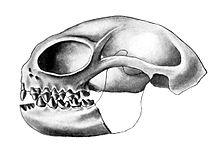Omomyidae
| Omomyidae | |
|---|---|

| |
| The skull ofAnaptomorphus | |
| Scientific classification | |
| Domain: | Eukaryota |
| Kingdom: | Animalia |
| Phylum: | Chordata |
| Class: | Mammalia |
| Order: | Primates |
| Suborder: | Haplorhini |
| Clade: | †Omomyiformes |
| Superfamily: | †Omomyoidea |
| Family: | †Omomyidae |
| Subgroups | |
| Synonyms | |
Omomyidaeis a group of earlyprimatesthat radiated during theEoceneepoch between about55 to 34million years ago(mya). Fossil omomyids are found in North America, Europe & Asia, making it one of two groups of Eocene primates with a geographic distribution spanningholarcticcontinents, the other being the adapids (familyAdapidae). Early representatives of the Omomyidae and Adapidae appear suddenly at the beginning of the Eocene (56 mya) in North America, Europe, and Asia, and are the earliest known crown primates.
Characteristics
[edit]
Features that characterize many omomyids include large orbits (eye sockets), shortenedrostraand dental arcades, loss of anterior premolars, cheek teeth adapted for insectivorous orfrugivorousdiets, and relatively small body mass (i.e., less than 500 g). However, by the late middle Eocene (about 40 mya), some North American omomyids evolved body masses in excess of 1 kg (2.2 lb) and frugivorous orfolivorousdiets.The largestomomyids wereMacrotarsiusandOurayia,both at 1.5–2 kg (3.3–4.4 lb) in weight.[3]Large orbits in genera such asTetonius,Shoshonius,Necrolemur,andMicrochoerusindicate that these taxa were probablynocturnal.At least one omomyid genus from the late Eocene of Texas (Rooneyia) had small orbits and was probablydiurnal.
Likeprimatesalive today, omomyids had grasping hands and feet with digits tipped by nails instead of claws, although they possessedtoilet clawslike modern lemurs.[4]Features of their skeletons strongly indicate that omomyids lived in trees.[3]In at least one genus (Necrolemur), the lower leg bones, thetibiaandfibula,were fused as in moderntarsiers.This feature may indicate thatNecrolemurleaped frequently. Most other omomyid genera (e.g.,Omomys) lack specializations for leaping, and their skeletons are more like those of livingdwarfandmouse lemurs.
Omomyid systematics and evolutionary relationships are controversial. Authors have suggested that omomyids are either:
- stemhaplorhines[i.e., basal members of the group including livingtarsiersand anthropoids].[5]
- stemtarsiiformes[i.e., basal offshoots of the tarsier lineage].[6]
- stem primates more closely related to adapids than to living primate taxa.
Recent research suggests the Omomyiformes are stem haplorhines, making them likely aparaphyleticgrouping.[7]
Attempts to link omomyids to living groups have been complicated by their primitive (plesiomorphic) skeletal anatomy. For example, omomyids lack the numerous skeletal specializations of living haplorhines. These haplorhine adaptations - absent in omomyids - include:
- significant reduction of the canal for thestapedial branchof theinternal carotid artery.
- route of the canal to house the promontory branch of the internal carotid artery through theauditory bullaof the temporal bone, i.e. "perbullar" (rather than across thepromontory of tympanic cavity,"transpromontorial" ).
- contact between thealisphenoidandzygomaticbones.
- presence of an anterior accessory cavity confluent with thetympanic cavity.
Omomyids further demonstrate a gap between the upper central incisors, which presumably indicates the presence of arhinariumandphiltrumto channel fluids into thevomeronasalorgan. Omomyids as a group also lack most of the derived specializations of living tarsiers, such as extremely enlarged orbits (Shoshoniusis a possible exception), a large supra-meatalforamenfor ananastomosisbetween theposterior auricularandmiddle meningeal circulation(again,Shoshoniusis a possible exception, but the contents of the foramen in this extinct taxon are unknown), and extreme postcranial adaptations for leaping.
Among primates, omomyids have a uniquely derived characteristic. This is the presence of an aphaneric (not visible or readily distinguishable, due to its position), or "intrabullar" (within the bullae),ectotympanicbone, connected to the lateral wall of the auditory bulla by an unbroken annular bridge.
Classification
[edit]This sectionneeds additional citations forverification.(December 2023) |
- Family Omomyidae
- Altanius
- Kohatius
- SubfamilyAnaptomorphinae
- SubfamilyMicrochoerinae
- SubfamilyOmomyinae
- Brontomomys[9]
- Diablomomys
- Ekwiiyemakius[9]
- Gunnelltarsius[9]
- Huerfanius
- Mytonius
- Palaeacodon
- TribeRooneyini
- TribeSteiniini
- TribeUintaniini
- TribeHemiacodontini
- TribeOmomyini
- TribeMacrotarsiini
- TribeWashakiini
- TribeUtahiini
References
[edit]- ^Savage, RJG, & Long, MR (1986).Mammal Evolution: an illustrated guide.New York: Facts on File. p. 365.ISBN978-0-8160-1194-0.
{{cite book}}:CS1 maint: multiple names: authors list (link) - ^Morse, Paul E.; Chester, Stephen G. B.; Boyer, Doug M.; Smith, Thierry; Smith, Richard; Gigase, Paul; Bloch, Jonathan I. (2019-03-01)."New fossils, systematics, and biogeography of the oldest known crown primate Teilhardina from the earliest Eocene of Asia, Europe, and North America".Journal of Human Evolution.128:103–131.doi:10.1016/j.jhevol.2018.08.005.ISSN0047-2484.PMID30497682.S2CID54167483.
- ^abRachel H. Dunn. "Additional postcranial remains of omomyid primates from the Uinta Formation, Utah and implications for the locomotor behavior of large-bodied omomyids".Journal of Human Evolution Volume 58, Issue 5, May 2010, pp. 406-417
- ^"Early Primates Groomed with Claws".
- ^Kay, Richard F.; Ross, Callum; Williams, Blythe A. (1997). "Anthropoid origins".Science.275(5301): 797–804.doi:10.1126/science.275.5301.797.PMID9012340.S2CID220087294.
- ^Szalay, Frederick (1976). "Systematics of the Omomyidae (Tarsiiformes, Primates): Taxonomy, phylogeny, and adaptations".Bulletin of the American Museum of Natural History.156(3): 157–450.
- ^Rossie, James B.; Smith, Timothy D.; Beard, K. Christopher; Godinot, Marc; Rowe, Timothy B. (2018)."Nasolacrimal anatomy and haplorhine origins".Journal of Human Evolution.114:176–183.doi:10.1016/j.jhevol.2017.11.004.ISSN0047-2484.PMID29447758.
- ^abPerry, J. M. G.; Dutchak, A. R.; Theodor, J. M. (2023)."New primates from the Eocene of Saskatchewan, Canada: Revision of the primates from the Cypress Hills Formation with description of new taxa".Palaeontologia Electronica.26(2). 26.2.20.doi:10.26879/1246.
- ^abcAmy L. Atwater; E. Christopher Kirk (2018). "New middle Eocene omomyines (Primates, Haplorhini) from San Diego County, California". Journal of Human Evolution. in press. doi:10.1016/j.jhevol.2018.04.010.




